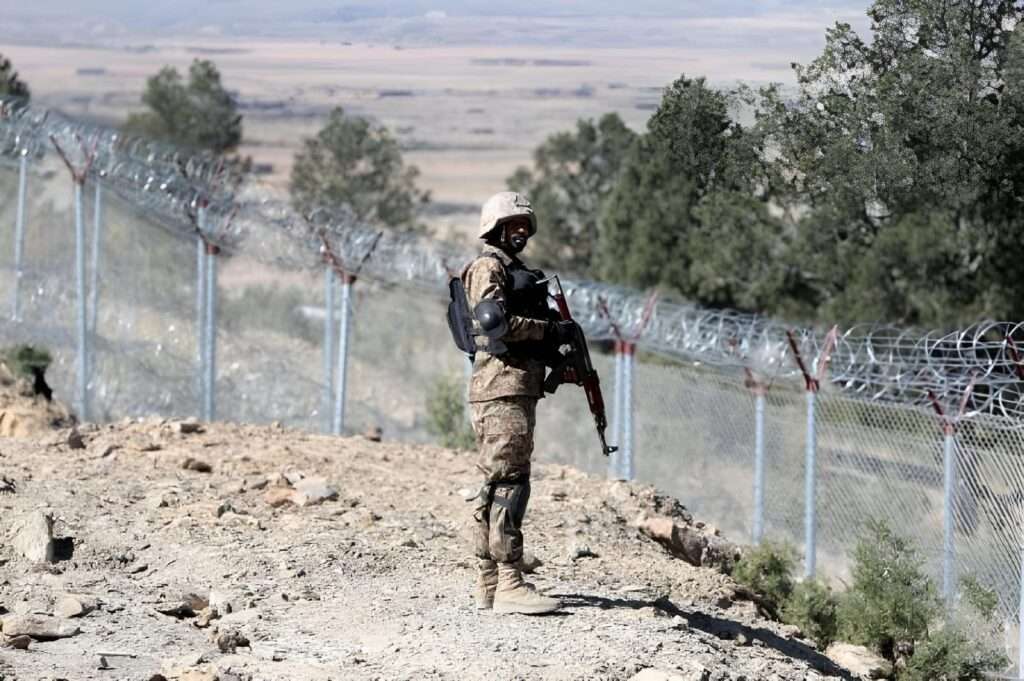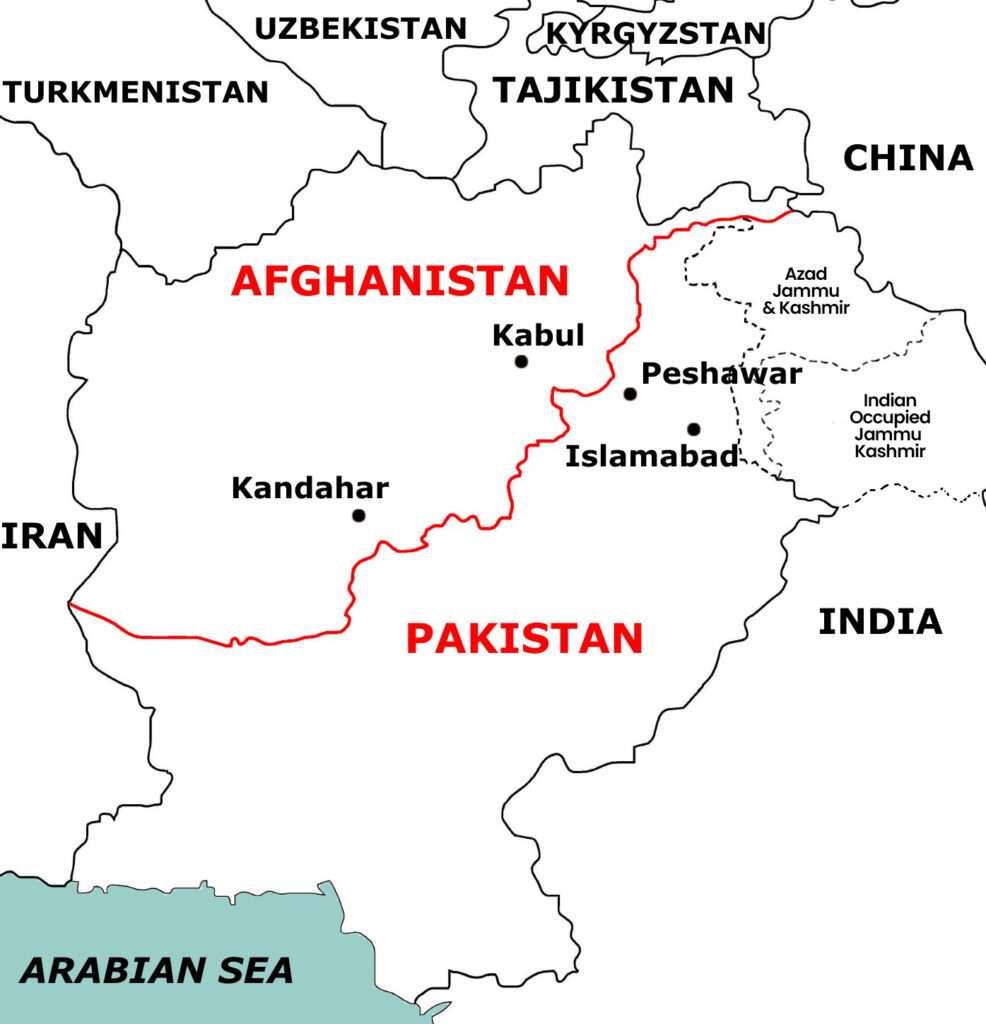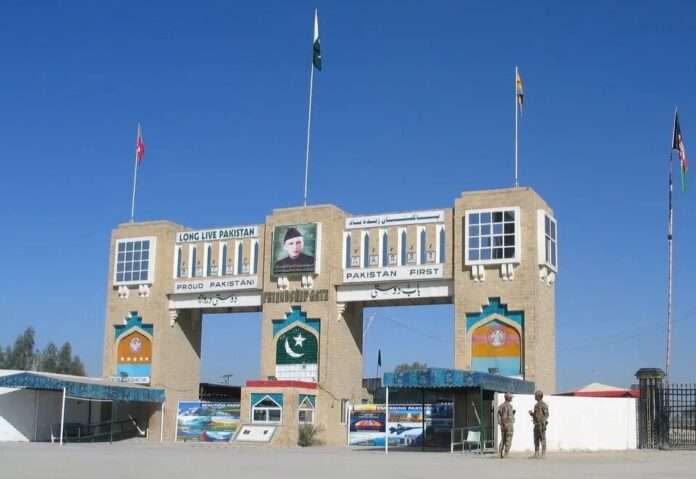Pakistan and Afghanistan are next door neighbors with predominant Muslim population along with joint historic cultural linkages; however, the relations between these two predominantly Islamic countries were never pleasant since day one. Analyzing demo graphically, Southern and Eastern Afghanistan is predominately Pashto-speaking like the adjacent Khyber-Pakhtunkhwa (KP), Federally Administered Tribal Areas, and northern Balochistan regions in Pakistan. This entire area is inhabited by the indigenous Pashtuns who belong to different Pashtun tribes. Till the previous Afghan government, relations between the two countries have been subject to various complexities over the decades by issues related to the Durand Line, the 1978 Soviet invasion, the recent war that resulted after 9/11, Afghan refugees, Tehreek-e-Taliban Pakistan (TTP) insurgency and border skirmishes, etc. The topic of Durand Line (the border between Pakistan and Afghanistan) is sensitive in nature for a variety of reasons and for different sects of people across the border. Looking deeper into it, when late and recent ancient history is reviewed, we find different power poles crossing the Hindukush Mountains and invading the subcontinent and this continued throughout the course of regional history. Since the majority of invaders coming from Central Asia and from Afghanistan, the myth is that Afghanistan boundaries up to the Indus River (greater Khorasan). The Pashtun nation is the common factor between the two countries and in fact, Pakistani Pashtuns are more in population than Pashtuns living In Afghanistan.
History of Durand Line
The Durand Line was established after the 1893 Durand Line Agreement between Sir Henry Mortimer Durand of colonial British India and Ameer Abdur-Rahman Khan of Afghanistan for fixing the limit of their respective spheres of influence. The single-page agreement, which contained seven short articles, was signed by Mr. Durand and Ameer Abdur-Rahman Khan agreeing not to exercise political interference beyond the frontier line between Afghanistan and what was then the British Indian Empire. Shortly after the demarcation of the Durand Line, the British began connecting the region on its side of Durand Line to the vast and expansive railway network. Concurrently, the Afridi tribesmen began to rise up in arms against the British, creating a zone of instability between Peshawar and the Durand Line. As a result, travel across the boundary was almost entirely halted. By the time of the sub-continent independence movement, prominent Pashtun nationalists such as Abdul Ghaffar Khan advocated unity with the nearly formed Dominion of India, and not a united Afghanistan. By the time of Pakistan’s independence movement, popular opinion among Pashtuns was split amongst the majority who wished to join Pakistan.
Adding a few words to the historical perspective under which this treaty was signed will be important for readers. In 1839, during the First Anglo-Afghan War, the British-led Indian forces invaded Afghanistan and initiated a war with the Afghan rulers. Two years later in 1842, the British were defeated that ended the war. In 1878 the British once again invaded Afghanistan during the Second Anglo-Afghan War. The British were successful in installing an Amir – Abdur Rahman Khan and the Treaty of Gandamak was signed in 1880. Afghanistan ceded control of various frontier areas to the British Empire while the British, in addition to having attained all of their geopolitical objectives, withdrew.
In 1893, Mortimer Durand was dispatched to Kabul by the government of British India to sign an agreement with Amir Abdur Rahman Khan for fixing the limits of their respective spheres of influence as well as improving diplomatic relations and trade. On 12 November 1893, the Durand Line Agreement was reached. The two parties later camped at Parachinar, which lately became part of the Federally Administered Tribal Areas (FATA) of Pakistan and is now part of KP to delineate the frontier.
From the British side, the camp was attended by Mortimer Durand and Sahibzada Abdul Qayyum, the Political Agent Khyber Agency representing the British Viceroy and Governor General. The Afghan side was represented by Sahibzada Abdul Latif and a former governor of Khost Province in Afghanistan, Sardar Shireendil Khan, representing Amir Abdur Rahman Khan. The original 1893 Durand Line Agreement was written in English, with translated copies in Dari language. The resulting Agreement or Treaty led to the creation of a new province called the North-West Frontier Province, it is now known as Khyber Pakhtunkhwa, a province of Pakistan which includes FATA and the Frontier Regions. This Treaty also led to Afghanistan receiving Nuristan and Wakhan corridor that separates Pakistan from Tajikistan. Pakistan inherited the Durand Line Agreement after its independence in 1947 but there has never been a formal agreement or ratification between Islamabad and Kabul. The Afghan government has not formally accepted the Durand Line as the international border between the two states, claiming that the Durand Line Agreement has been void in the past. This complicated issue is very sensitive to both the countries. The Afghan government worries that if it ever ratifies the agreement, it will permanently divide the 50 million Pashtuns and thus create a backlash in Afghanistan. Pakistan feels that the border issue was resolved before its birth in 1947. This complicated border has always served as the main trade route between Afghanistan and the South Asia, especially for supplies into Afghanistan. Shortly after Pakistan gained independence in 1947, Afghanistan crafted a two-fold strategy to destabilize the frontier regions of Pakistan, in an attempt to take advantage of Pakistan’s post-independence instability. It strongly aligned itself with Pakistan’s rival, India, and the USSR, which later invaded Afghanistan in 1979.

Relations between Afghanistan and Pakistan began deteriorating in the 1970s after Pakistan supported resistance leaders such as Gulbuddin Hekmatyar, Ahmad Shah Massoud, Jalal Uddin Haqqani, and others against the governments of Afghanistan. In April 1978, Afghan President Daoud Khan was assassinated in Kabul during the Saur Revolution. This was followed by the execution of deposed Pakistani Prime Minister Zulfikar Ali Bhutto in April 1979 and the assassination of Afghan President Nur Muhammad Taraki in September 1979. After the Soviet invasion of Afghanistan in December 1979, the United States joined Pakistan to counter Soviet influence with active help from Pakistan’s premier intelligence agency, the Inter Services Intelligence (ISI) and advanced its own interests in the region. In turn, Afghan, Indian and Soviet intelligence agencies played their role by supporting al-Zulfikar – a Pakistani leftist group responsible for the March 1981 hijacking of a PIA plane. During the 1980s, the Durand Line was heavily used by Afghan refugees fleeing the Soviet occupation in Afghanistan, including a large number of Mujahideen insurgent groups who crossed back and forth. The Mujahideen included not only locals but also Arabs and others from over 40 different Islamic nations. Many of these foreign fighters married local women and decided to stay in Pakistan, among them were radical Muslims such as from the Egyptian Muslim Brotherhood.
After the Soviet withdrawal from Afghanistan in 1988 and then the collapse of USSR, the country was engaged in internal civil war for a few years and witnessed power struggles between various Mujahideen groups. The Pakistan Embassy in Kabul also came under attack and was burnt and the Ambassador was also badly injured because of Afghan groups attacking the Embassy during that lawless period. Around September 1994, the Taliban movement captured the Afghan city of Kandahar and began its long conquest with Pakistan’s political support. The Taliban claimed that they wanted to clean Afghanistan from warlords and criminals.
In late 1996, the Islamic Emirate of Afghanistan emerged and established close relations with neighboring Pakistan. However, the relations began to decline when the Taliban refused to endorse the Durand Line despite pressure from Islamabad, arguing that there shall be no borders among Muslims. When the Islamic Emirate of Afghanistan was toppled and the new Afghan government was formed, President Hamid Karzai began parroting the previous Taliban statement. This is the historical perspective, but even now, the newly formed Taliban government who took over control in Kabul in August 2021, have shown hesitance to endorse the Durand Line. There is no sign and willingness of acceptance from the Taliban rank and files on this sensitive issue.
The fact and related myth on the subject should be evaluated on the basis what is the real ground situation. The people of KPK (previously North Western Frontier Province) opted the choice through a referendum to join Pakistan during the British sub-continent partition. The people of tribal areas offered Muhammad Ali Jinnah the full support and security of the frontiers between newly formed Pakistan and Afghanistan. It is a reality that the relatives and kith and kin live across the border between Pakistan and Afghanistan yet, the tribal elders and general population were always faithful and supporters to the sovereignty of Pakistan. One of the major examples can be quoted when these were the tribal people who took over Azad Kashmir from Indian Dogra forces and this was a great military achievement in favor of Pakistan.
If we analyze the economic situation, a huge volume of trade exists between the two countries. There are two main entry trade points where trade is done through official channels. Afghanistan is a land locked country and rely heavily on Pakistan for its trading and import exports etc. Pakistan is trying to maneuver the land locked status of Afghanistan for the benefit of both countries without resorting to hostility. However, recently Pakistan had to close all borders with Afghanistan due to continuing terrorist attacks and deteriorating law and order situation – the situation got better after this border closure. Consequently, the economy of Afghanistan receiving a jot during this border closure, resulting in peaking prices of all utilities thereby cementing the impression on Afghan society that Pakistan is vital for Afghanistan’s prosperity and matters concerning day to day Afghan lifeline. The Pakistani Rupee is a powerful tool and is being utilized widely inside Afghanistan. Pakistan has suffered heavily in the recent past due to porous Durand Line and in the absence of any effective border management. Terror outfits have used Afghan soil as a haven from where they have launched brutal attacks on civilians and other infrastructure. Pakistan has lost around 80 thousand people during the war on terror and one of the main reasons was the harsh terrain of the Durand Line.
Finally, after the very tragic Army Peshawar School (APS) incident, a harsh realization dawned nationwide that an effective border management is necessary to control and regulate the law and order situation in Pakistan since it was established that TTP and JUA terrorists enter Pakistan from the free Afghan border crossings during the previous regime’s tenure. Since then some very good steps have been taken by Pakistan, like building gates on the border to regulate visa entries and building of a fence across the western border. These steps are very important and will create an image and sense of realization amongst Afghans that it is now very tough to enter Pakistan without proper visa/ papers like any other country in the world.

Concluding Remarks
Regardless of so-called claims by the Afghan side, the Durand Line is the official recognized border between Pakistan and Afghanistan (a 2,670-kilometre international land border between the two countries where the western end runs to the border with Iran and the eastern end to the border with China). Some other questionable areas were also settled during this treaty for example Nuristan and Wakhan Corridor that annexed to Afghanistan because of this Parachinar Agreement.
Pashtuns living in Pakistan are more pro-Pakistan than any other preferences, their economic and religious affinity with Pakistan is without any boundaries that’s why they are called defenders of Pakistan on the western side. This is the reason that despite spreading propaganda the Pashtunistan movement in the past and Pashtun Tahafuz movement (PTM) recently, did not provide any significant results and Pakistani Pashtuns remain faithful with the sovereignty of Pakistan. The border between Pakistan and Afghanistan is now being fenced with designated border crossing points for trade and travel which will eliminate any terror outfit crossing the border and hence peace, security and trade will be enhanced. My advice to the Pakistan government will be to handle this border issue with utmost delicacy with the current Taliban regime (but after it gets international legitimacy). There is no apparent rush to have Durand Line recognized by Afghanistan, despite Durand Line is the international recognized Border regardless. Rather, Pakistan can heavily facilitate the people to people travel via border points by decreasing the long waiting time, clearance of the elderly on priority basis and extending the border crossings timings, etc. The bottom line is that Durand Line will continue to be a myth, a legend, and an extended legacy to Pakistan for the near- and long-term future and Pakistan should be ready for it.





